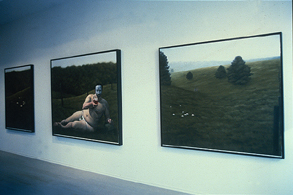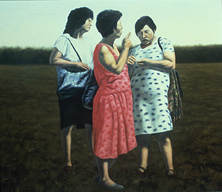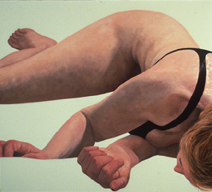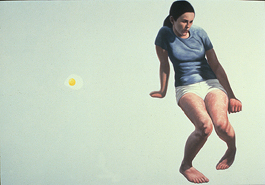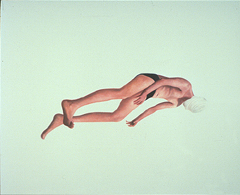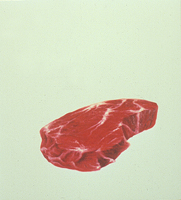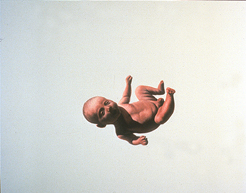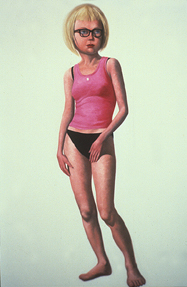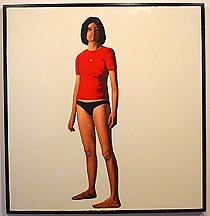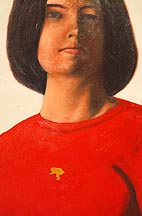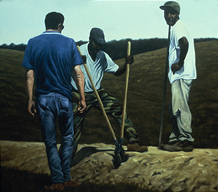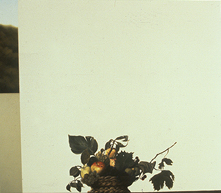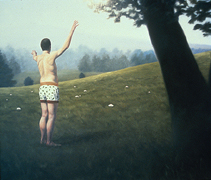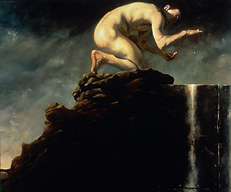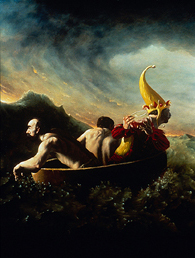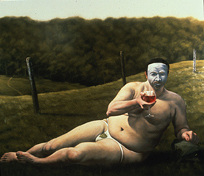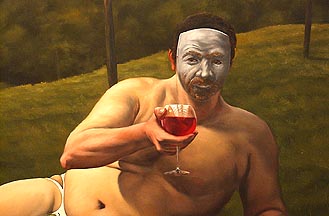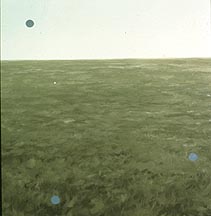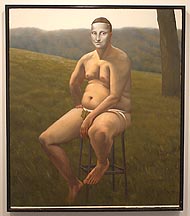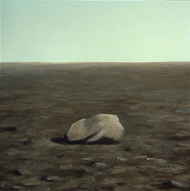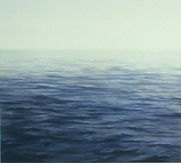ARTH Courses | ARTH 200 Assignments
Karl Connolly: Figurative Paintings
SUNY College at Oneonta
Fine Arts Gallery
November 5- December 12, 2001
Gallery Hours: Monday-Friday, 11 AM -4PM.
A Lecture by the Artist will be given Friday, November 30 at 4:00 PM in Instructional Resource Center- Lecture Hall #8.
A Reception will be held following the lecture in the Fine Arts Gallery.
Gallery
Critical Responses
Excerpts from a review of Karl Connolly's work at the C. Grimaldis gallery in Baltimore. The review by Joe Shannon appeared in Art in America (November, 2000):
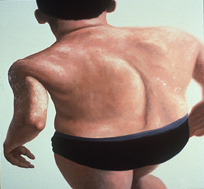 In
Karl Connolly's painting A Matter of Time (2000), almost the entire
surface is taken up by a man's bare back. About 5 feet of reddening Anglo
skin is painted to suggest an approaching sunburn with its inevitable blisters
and peeling. It is not a pretty picture --but I could not take my eyes off
it. The man's torso is widened and squashed, as if a source photo had been
manipulated by a computer before the image was painted. The figure's elephantine
compression and the raw burning hide are compelling and unforgettable elements.
In
Karl Connolly's painting A Matter of Time (2000), almost the entire
surface is taken up by a man's bare back. About 5 feet of reddening Anglo
skin is painted to suggest an approaching sunburn with its inevitable blisters
and peeling. It is not a pretty picture --but I could not take my eyes off
it. The man's torso is widened and squashed, as if a source photo had been
manipulated by a computer before the image was painted. The figure's elephantine
compression and the raw burning hide are compelling and unforgettable elements.
There is
a rawness to all of Connolly's big figure pieces, which are often silhouetted
against bright white. The most successful paintings in the show are stunning,
but several others try too hard to break new ground; the artist's strategies
and distortions become a little too self-conscious. Stretch (2000)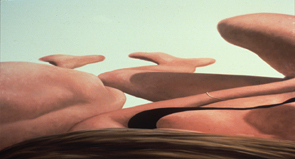 an abstract close-up of a bather, has nowhere near the power of a
Matter of Time. In Still
Life with Frog
(1999), a single standing bather is awkward and stiff, without any of
the convincing tactile presence of, say, Point (1999).
an abstract close-up of a bather, has nowhere near the power of a
Matter of Time. In Still
Life with Frog
(1999), a single standing bather is awkward and stiff, without any of
the convincing tactile presence of, say, Point (1999).
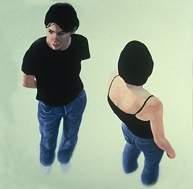 For
me, Point is the most realized of the figure paintings. It shows two
women seen from above. The blue-white background, more than a neutral backdrop,
interlocks with the figures. The depiction of the accurately rendered, blue-jean-clad
women captures Connolly's edgy method, without the clamoring distortions.
The riveting simplicity of the composition, coupled with the wary, yet defiant
expression of the woman facing us, offer the artists at his best.
For
me, Point is the most realized of the figure paintings. It shows two
women seen from above. The blue-white background, more than a neutral backdrop,
interlocks with the figures. The depiction of the accurately rendered, blue-jean-clad
women captures Connolly's edgy method, without the clamoring distortions.
The riveting simplicity of the composition, coupled with the wary, yet defiant
expression of the woman facing us, offer the artists at his best.
The large figurative pieces so occupied my attention that I almost overlooked a group of landscapes. Simple painterly studies of fields with trails running through them are presented on small panels rich with gray-greens and deft brushwork. I think they sould have been in a separate room, away from the din of Point and A Matter of Time. This separation would have given each group of works an equal standing, providing a clearer appreciation of Connolly's range.
Stage Painting #3: Dionysus.
Mike Giuliano, " The Gods Must be Crazy: Tweaking the Old Master at C. Grimaldis," Gallery: Karl Connolly turns the past to present advantage in his paintings. Adept at emulating the well-muscled figuration, mythological references, theatricality, and glossy surfaces of old-master-style- oil painting, this young Baltimore artist manages to both respect and poke fun at that tradition.
For abundant proof, just look at Connolly's "Stage Painting #3: Dionysus." The fleshy guy reclining in a field is ribald even by the generous standards of Dionysian depictions. As if the glistening grossness of all that blubber weren't enough, the god is clad only in a white jockstrap that is adorned in front with a green fig leaf. He holds a glass of red wine as if to toast us. Not even Orson Welles at his wine-shilling heftiest made such a corpulent impression.
Dionysus seems like a signature image for the exhibit as a whole. Just as that Greek god represented the unleashing of libidinal forces, Connolly likes to play naughty tricks on the polite Apollonian conventions of classical art.
And just as Dionysus doesn't operate in a subtle fashion, there is an overt theatricality about Connolly's approach. It's not simply a matter of the bulky god inviting us to share a glass with him. And there's another component to this highly stage-managed picture: the mostly nude Dionysus wears a gray mask as if prepping for a costumeless-but-masked ball.
It gets more complicated than that. If a mask's usual function is to conceal its wearer's identity, this one follows the contours of the god's face closely enough to make the mask seem like the face itself. In fact, the mask is bearded, much as if there were little distinction between face and mask.
What should be made of all of this, especially in light of the masks worn by some of the figures in other Connolly paintings? Like actors in artifice-ridden theatrical vignettes, these subjects show you everything and nothing about themselves. You can belly up to Dionysus, but his pickled brain is off limits. You can recognize references, admire the realistic exactitude of Connolly's brushwork, and in general feel like you know where you are in art-historical terms, but these spare, near-surreal compositions mask any certain thematic readings.
Consider the three jockstrap-clad men conversing on a gently rolling hillside in "Stage Painting # 2: Conversation." We haven't a clue as to what they're discussing, much less why they're all but nude. They are relatively small figures within a bucolic landscape, so we turn our attention to any clues it might offer. Most of the space around them is just a big green field, so we could be anywhere in Arcadia. There are a few trees, or are they big bushes? There's a section of a wooden fence, but we don't know whether that evocation of demarcation and enclosure bodes well or ill for the men. Most disturbingly, the green grass is punctuated by a few white mushrooms so large they seem like an enigmatic species that could prove either delicious or deadly.
Similar fungal growths pop up in other paintings too, like slightly creepy props that suddenly decided to poke through an otherwise manicured carpet of grass. Connolly also has two still-life paintings of mushrooms, in which their forms are as suggestive as your imagination cares to make them.
His exhibit as a whole aims for a balance between fairly large paintings in which figures and the occasional prop are set amid relentlessly green landscapes and very small paintings in which elements of thsoe landscapes are looked at in more detail. The smaller paintings are akin to photographic snapshots that focus on portions of the overall scene. A bit of field might be seen in one, a tree trunk in another, a forest path in another: The focus is sharp in some of these paintings, and more blurry in others.
Although these small paintings are extremely well-done and have enough theoretical basis to make the successful, they don't really add much visual information that we haven't already encountered in the larger canvases. Rather than being intriguing variations on a theme, they verge on redundancy....
John Dorsey, "Connolly has light touch with illusion," The Sun, 10/12/95: In making his fine paintings on display at Grimaldis, Karl Connolly creates illusion but gives us the tools to see through it. Then, if we want, he allows us to have illusion back again.
Connolly creates paintings that are naturalistic looking, then shows you that they are not at all what they seem. "Bidoing" is a good example. Kneeling upon a rock landscape in front of a stormy sky, a nude man in the process of dropping marbles in a metal drum turns to look, as if suddenly startled by the presence of the viewer. (The name of the painting comes from the sound the marble makes when it hits the metal).
As we look at the painting, we begin to realize the artist has provided us with clues that break down the illusion that we are seeing something real. Chief among them is the light. A strong light --sunlight, of course, since we're outdoors-- shines on the figure from behind and above the viewer. Yet the sky that we see is dark with storm clouds; no sun would shine through those clouds. Then down at the lower left, we notice a sunset in the far background of the scene; the sun can't be shining from behind us and in front of us at the same time.
This light, we realize, is not real light; it's created by paint. The longer we stare at the painting the more see paint: the paint that creates light, flesh, metal, rocks. It is all just paint.
This experience happens repeatedly in Connolly's works here --the light impossibly coming from more than one source, the objects in the painting dissolving into pure paint as you look at them.
If the way Connolly uses the paint relates to illusion, the meanings of his works deal with the same subject. On one level, he appears to be making the point that self-importance blinds us to the realities of life --especially to its ultimate meaningless.
The people who inhabit Connolly's narrative paintings, such as "Eggcatcher" and "Bidoing," are living in worlds of illusion, far from reality. So is the Emperor without clothes in Connolly's two "Emperor" paintings.
Elsewhere, the two "Sanctuary" paintings also refer to illusions; the closed-in rocky spaces depicted are prisons more than sanctuaries.
"Hat Painting I" refers to a figure in Luca Giordano's painting, "Ecce Homo," at the Walter Art Gallery.
By painting only the hat, Connolly indicates that it's the only thing of substance about the puffed-up figure we see in the other painting.
But Connolly's paintings are not ultimately pessimistic. In the very act of painting, which he does so well, Connolly attests to his hope that going on has its own meaning.
Even in their foolishness, his figures are endowed with a humanity that insists we accept them at face value or risk the destruction of our own illusions. In the end, the paint once more disappears and the painting becomes what it was at first --a beautiful picture-- and we are safe.
Connolly's work as the strength of its own contradictions.
